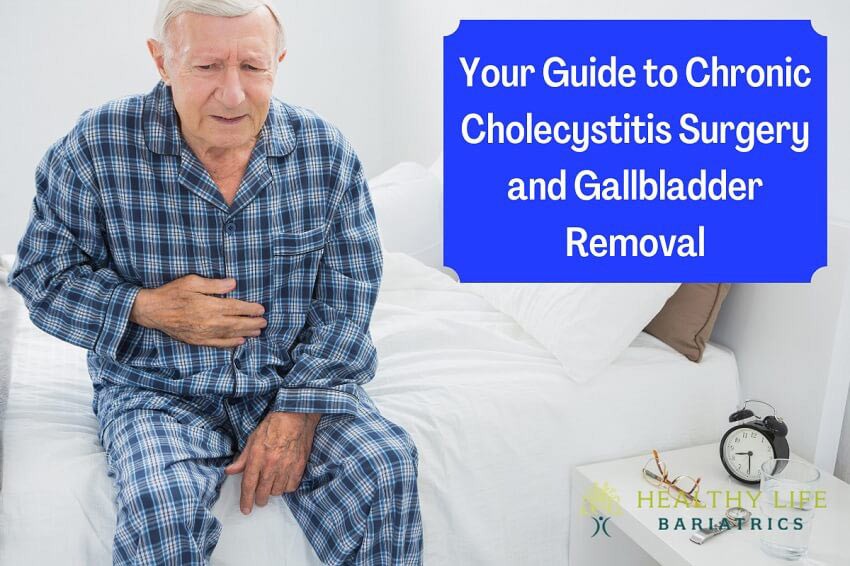
Introduction Chronic Cholecystitis Surgery and Gallbladder Removal – The Complete Guide
Did your doctor recently diagnose you with chronic cholecystitis? Or maybe you came across the term while searching for symptoms of upper abdominal pain on the internet. Regardless of where you stumbled across the medical term, you have questions. This guide is chronic cholecystitis meant to provide the answers.
What follows are the most commonly asked questions about gallbladders, gallstones, and the issues surrounding them, which include chronic cholecystitis. The good news is that these conditions are treatable, and the procedure – known as chronic cholecystitis surgery – is associated with a low risk of complications. If you still have questions after reading, you are encouraged to schedule a consultation with Doctor Babak Moeinolmolki of Healthy Life Bariatrics by calling (310)861-4093.
What is Chronic Cholecystitis?
Chronic cholecystitis is a medical condition characterized by swelling and irritation of the gallbladder that worsens over time. The gallbladder is an organ located underneath the liver that stores bile. The liver makes bile, which helps with the digestion of fats in the small intestine.
Acute cholecystitis or sudden cholecystitis is caused by gallstones in the gallbladder. Repeated attacks of sudden cholecystitis are diagnosed as chronic cholecystitis.
Over time, these repeated attacks can cause the gallbladder walls to thicken. As a result, the gallbladder shrinks and is no longer able to store or release bile.
More women than men over experience these gallstone attacks, and the condition seems to be more common after age 40. Birth control pills and pregnancy can increase the risk for gallstones, which is the primary cause of both sudden and chronic cholecystitis.
Does Chronic Cholecystitis Require Surgery?

Chronic Cholecystitis Surgery and Gallbladder Removal LA, CA
Surgery is not the automatic course of treatment for this condition. For repeated attacks of acute cholecystitis, a hospital stay is sometimes necessary to control gallbladder inflammation. If the inflammation cannot be controlled with time and medication, surgery may be required to control the signs and symptoms of the disease.
How is Chronic Cholecystitis Diagnosed and What Does it Mean?
Most people are diagnosed with chronic cholecystitis after visiting their doctor on account of the symptoms they experience. Symptoms include a dull pain in the upper right or middle of the belly and steady pain that lasts around a half hour.
Your doctor wants to be sure you actually have the condition before treatment can be recommended. Doctors diagnose chronic cholecystitis with blood tests to determine if the inflammation of the gallbladder is present. Imaging tests of your gallbladder are used to identify gallstones in the bile ducts of your gallbladder. Another test known as a hepatobiliary iminodiacetic acid (HIDA) scan can be used as well, which tracks the production and flow of bile from your liver to your small intestine to pinpoint any blockage.
While the condition can be serious, treatment can usually relieve symptoms and future occurrences of the chronic disease. In severe cases, the gallbladder may have to be removed entirely.
What is the Difference Between Acute and Chronic Cholecystitis?
With acute cholecystitis, symptoms are less severe and do not last very long. Chronic cholecystitis involves recurring attacks of pain that may require a hospital stay to control symptoms of the disease.
Can You Live Without a Gallbladder?
While the gallbladder serves an important function in the body, you may be surprised to learn you can lead a perfectly normal life without the organ. The liver still makes enough bile to digest food, even without the gallbladder being present to store and release bile. Instead of bile being stored in the gallbladder, the fluid will drip continuously into your digestive system.
What Does Chronic Gallbladder Pain Feel Like?
The symptoms of chronic gallbladder pain can vary depending on the person. Some individuals experience yellowing of the skin and whites of the eyes, which is a condition called jaundice. Nausea and vomiting may be present, along with fever, and clay-colored stools. Most people at least feel a sharp, cramping, or dull pain that spreads to the back and below the right shoulder. Your gallbladder in the middle or upper middle of your belly may be tender. The pain usually lasts for around thirty minutes.
What is a Classic Symptom of Cholecystitis?
The classic symptom of cholecystitis is a pain in the middle or right upper side of your belly, where your gallbladder sits underneath your liver.
Does Cholecystitis Require Major Surgery?

Chronic Cholecystitis Surgery and Gallbladder Removal LA, CA
While it may be possible to control symptoms to some degree, and for a while, most people with chronic cholecystitis eventually require gallbladder surgery. Unlike major “open” surgeries, where the surgeon needs to open your body cavity, gallbladder removal surgery is minimally invasive. The procedure involves a few tiny incisions around your abdomen and the use of a laparoscopic camera and associated tools.
Open surgeries are still used for severe cases when minimally invasive procedures are not possible. Examples include if there is severe inflammation of the gallbladder or bile duct or if you have high pressure in liver blood vessels.
Read our article: Top Surgical Procedures for Hernias, Gallbladder Issues, and GERD
When is Surgery Required for Cholecystitis?
Surgical removal of the gallbladder (cholecystectomy) is required if there are gallstones in the gallbladder, known as cholelithiasis), gallstones in the bile duct (choledocholithiasis), gallbladder inflammation (cholecystitis), and large gallbladder polyps. Pancreas inflammation (pancreatitis) due to gallstones can also warrant gallbladder removal.
How Long is Gallbladder Removal Surgery?
Laparoscopic gallbladder removal surgery takes between one and two hours from start to finish. After the general anesthesia takes effect, the surgeon makes tiny incisions on the abdomen. The gallbladder is removed with laparoscopic tools before the incisions are sutured closed. You are then taken to a recovery area, where your vital signs will be monitored until you are free to recover at home.
Can You Still Have Cholecystitis After Gallbladder Removal Surgery?
As long as the gallbladder is removed, cholecystitis symptoms should resolve. However, some people develop symptoms similar to those caused by gallstones following surgery. There may be tummy pain, diarrhea, indigestion, a high temperature (fever), and jaundice.
This grouping of symptoms is known as a post-cholecystectomy syndrome (PCS). Experts suspect this is caused by bile leaking into the stomach or by gallstones being left behind in the bile ducts.
PCS symptoms are typically short-lived but can persist for several months. You are encouraged to contact your doctor if these symptoms continue. Follow-up surgery to remove any remaining gallstones could be required, though medications can also sometimes relieve PCS symptoms.
Can You Have Pain Years Following Gallbladder Removal?
While post-cholecystectomy syndrome usually only lasts a few months, if you experience any symptoms at all, the condition can persist for years after surgery. A follow-up surgery should help to remove the symptoms if they become persistent and severe.
Why Do Females Have Their Gallbladders Removed?

Chronic Cholecystitis Surgery and Gallbladder Removal LA, CA
The reason women tend to experience gallbladder issues more than men is because of the hormone production differences between the sexes. Estrogen and progesterone are produced more readily by women. These hormones contribute to the development of gallstones.
Estrogen increases the amount of cholesterol in bile. Cholesterol is a key component in the formation of gallstones. Progesterone, which is involved in the menstrual cycle, can slow down the process of bladder emptying. If the gallbladder cannot empty fast enough, gallstones can block the bile duct instead of being passed.
Because of these hormones, women aged 40 and under are three times more likely to experience gallstone problems than men of similar age. By age 60, both men and women are both likely to develop gallstones and the issues they cause, which include chronic cholecystitis.
What are the Four Fs of Cholecystitis?
The four Fs are used to identify the highest risk factors for the development of gallstones. They include fair (which implies female), fat, fertile, and forty. The implication is that women aged 40 and under who are overweight and fertile are at the highest risk for gallstone development and the issues they cause.
How Serious is Chronic Cholecystitis?
Anyone who has experienced the painful symptoms of chronic cholecystitis will tell you the condition is no walk in the park. If left untreated, the condition can lead to serious complications. Gallbladder rupture is one of the risks, which can be life-threatening.
How Can You Tell if Your Gallbladder Needs to be Removed?
A good indication that your gallbladder needs to be removed includes pain and fever. The pain is typically sharp and originates in your belly and radiates to your shoulder or back.
Can Gallbladder Rupture Lead to Death?
Up to 70% of individuals who experience gallbladder rupture face life-threatening conditions. This is why it is critical to get a diagnosis and treatment for acute cholecystitis or chronic cholecystitis the moment symptoms present themselves.
How is Chronic Cholecystitis Treated?
The most common treatment for repeated gallstone attacks is gallbladder removal surgery cholecystectomy. The surgery is minimally invasive and is associated with tiny incisions, a low chance of risks, and shortened recovery.
How Long Can You Put off Gallbladder Surgery?
When you experience severe gallbladder inflammation, your doctor may want to try to resolve the inflammation first before surgery is considered. Antibiotics are often employed during this waiting period to resolve the infection. Your doctor may not want to wait longer than 72 hours after chronic cholecystitis symptoms have been shown to persist, as that duration has been associated with a higher risk of complications and longer hospital stays.
Is Chronic Cholecystitis Painful?
The condition certainly does not feel good. The attacks associated with chronic cholecystitis are repeated and involve sharp, cramping, or dull pain that lasts for around thirty minutes.
How Long Does Cholecystitis Take to Heal?
A gallstone attack can last for up to two or three days. When the condition persists for months, with repeated attacks, that is an indication you have chronic cholecystitis.
Can Cholecystitis Cause Liver Problems?

Chronic Cholecystitis Surgery and Gallbladder Removal LA, CA
Yes! Acute cholecystitis is associated with impaired liver function. Delaying treatment can lead to liver damage, liver failure, or even death.
Can Chronic Cholecystitis Cause Pancreatitis?
In addition to liver damage, gallstones can also lead to inflammation of the pancreas (pancreatitis). Gallstones made in the gallbladder can slip out and block the bile duct. This can prevent pancreatic enzymes from traveling to the small intestine. Instead, the enzymes are forced back into the pancreas, which can lead to inflammation and other severe complications.
Still Have Questions about Chronic Cholecystitis Surgery? Schedule with Doctor Moeinolmolki in Los Angeles
Reading about conditions like chronic cholecystitis can be frightening when you experience the very symptoms associated with the disease. You should never attempt to self-diagnose, however. The best way to determine if you do suffer from acute or chronic cholecystitis is to schedule a consultation with Doctor Babak Moeinolmolki at Healthy Life Bariatrics in Los Angeles.
Doctor Moeinolmolki is a board-certified surgeon who specializes in minimally-invasive techniques like gallbladder removal (cholecystectomy). The condition involves tiny incisions, a lowered risk of complications, and shortened downtime.
Book your appointment by calling (310)807-2378.


